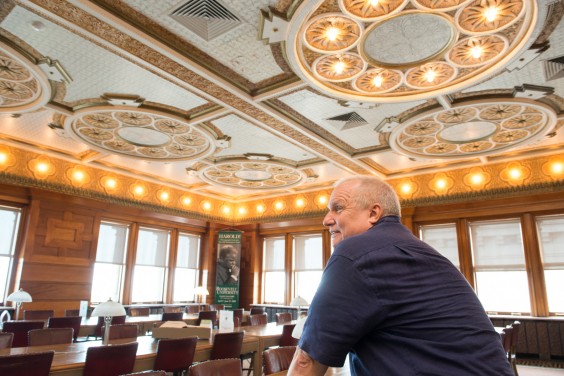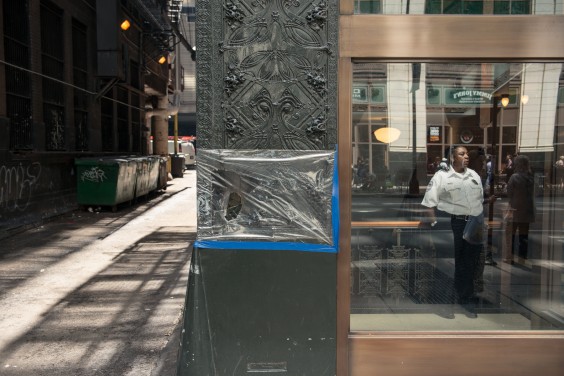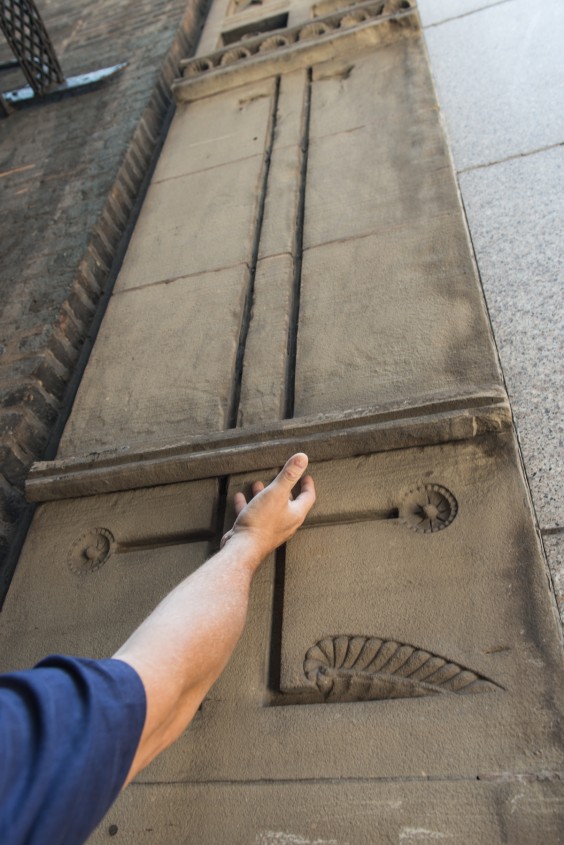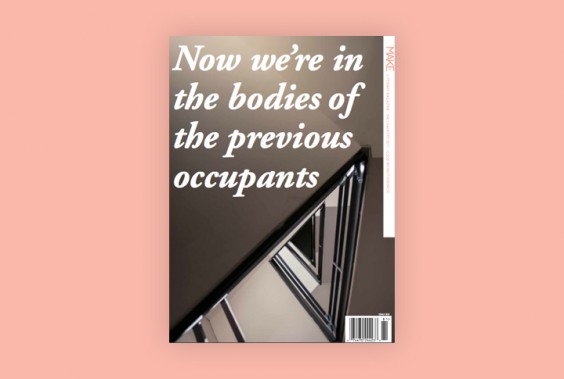
Aug 28, 2014

In 2002, the then Commissioner of the Chicago Department of Cultural Affairs, Lois Weisberg, met a man whose capacity for learning, internalizing, and sharing Chicago history—in particular, its architectural history—was so astonishing that she created the post of “Official Cultural Historian of the City of Chicago,” plucked him from the Chicago History Museum, and named him to it.
Tim Samuelson has suggested that great architecture “draws you in,” and he was first lured at age seven by a depiction of the Carson, Pirie, Scott and Company building in the pages of his grandmother’s Reader’s Digest. Samuelson requested to accompany her to the fabled department store on her next stocking purchase. From State Street, he looked up to discover the “merging of architectural and organic. The blossoming of elements and the merging of geometries. All of it so tactile.” So began his lifelong passion for Chicago, its architecture, and one of its greatest contributors, architect Louis Sullivan.
Samuelson may be an expert in Midwestern architecture, but his formidable knowledge does not end there. He’s uncovered the origins of the deep dish pizza and the TV informercial. He’s also written numerous books and magazine articles, as well as collaborated on projects with other culture makers, including Chris Ware and Ira Glass. His expertise has been called on internationally, and he has appeared on such programs as PBS’s Nova and The American Experience and the BBC’S Omnibus.
Samuelson’s devotion to Chicago architecture was clear even in his choice of college: he applied to Roosevelt University primarily due to the fact that it’s housed in Adler and Sullivan’s Auditorium Building. He admitted as much in his application, but at the suggestion of his high school counselor added, “And I hear they have a good English department.” We are all fortunate that Samuelson was accepted as a student. He immediately became an advocate for the building, helping restore it to its original splendor through vocal campaigns and quiet picking at hastily painted metalwork.
In August 2012, MAKE Creative Director Johnathan Crawford ventured to Expo 72 to photograph the historian in his artifact-filled office. Four hours later, Samuelson had led Crawford around the former bank, through Roosevelt’s Auditorium Building, over to Sullivan’s oldest standing Chicago building at 19 South Wabash, then onto the Carson Pirie Scott Building, and Roberto’s Clothing on State Street. The evidence is seen in the accompanying photographs. In this interview, Samuelson refers to the Auditorium Building as belonging among the most awe-inspiring architectural works. But you’ll find no photos of the building because, as he says, “It’s something that can’t be explained in words or pictures—you simply have to do it.”
In the following pages, Samuelson fields a variety of questions about Chicago architecture, history, and culture from four interested citizens.
A Q & A with Tim Samuelson, Chicago’s Official Cultural Historian
James Sommer, student of architecture and budding historical preservationist
MAKE: The University of Chicago’s Center for Cultural Policy recently released its major research study, “Set in Stone.” It examines the overbuilding seen in cultural institutions in Chicago and across the country. The Art Institute of Chicago’s Modern Wing is a prime example. These organizations now face financial strain as they struggle to pay for their amazing new structures. Do you feel the Art Institute’s decision to fund brick-and-mortar operations rather than programming was in poor taste? On the positive side, the city gained another architectural landmark, drawing in tourism and creating a richer landscape. What are your thoughts on this?
Tim Samuelson: It’s somewhat unfair in hindsight to criticize the Art Institute for its present-day struggles to sustain ambitious expansion programs planned in the more prosperous economic environment of the not-too-distant past. Like the optimistic planners of the pre–Great Depression era, the Art Institute was taking advantage of seemingly reasonable economic opportunities to obtain space for the display and protection of one of their signature collections. And even in the best of times, such expansions always carry a degree of risk from the future’s unknowns. In this instance, as well as back in 1929, the unknowns ultimately proved to cause difficult challenges.
I’m not in a position to evaluate the wisdom of the Art Institute’s long-range planning or the choices between programming or brick-and-mortar expansion. From a historical perspective, I think looking back at precedent can reasonably take away much of the blame and shame for the present-day situation. And it’s also possible to cite many examples where the difficulties of financial obligation resulting from ambitious pre-1929 crash projects proved to be good long-term investments in the end. But a good historian also has to give the warning that anything can happen, and often from the most unexpected sources and causes.
And from a distinctly Chicago perspective, I’d also have to add that taking risks and chances has always been part of the city’s fundamental character—and some amazing achievements have resulted from a built-in lack of fearlessness.
M: What do you see as the next “Chicago school” of architecture? Do you think Chicago remains at the forefront of contemporary architectural practices? Have we lost our claim as the skyscraper capital of the world as the Global South erects architectural monuments at record speeds?
TS: Chicago definitely retains a powerful and influential architectural voice. But in an era of instant communication and global sharing of ideas, it’s an open question if Chicago—or anyplace else for that matter—will ever again develop strong regionally exclusive movements parallel to those of the past.
A defining part of Chicago’s architectural reputation has always been as much about ideas as it has been about the design and construction of actual buildings. This shows no sign of going away—and it fits perfectly into today’s global communications.
Personally, I could care less which city happens to have the world’s tallest skyscraper at any given time. No matter what’s built where, the high-rise DNA will always show strong markers of Chicago.

M: Landmark Illinois and Preservation Chicago recently released their endangered building lists. Mid-century modern and postwar structures have an increased presence on this list—most notably, Bertrand Goldberg’s Prentice Women’s Hospital at Northwestern. As a tireless advocate for preservation, how do you suggest we reach out to the population to educate them on the significance of these structures to our city landscape and culture?
TS: Like people, buildings reach a mid-life crisis around the age of forty. Things start to fall apart and need some work. History has shown this to be a critical period when building owners try to make their buildings look young again by imposing bad face-lifts that ultimately fool nobody. And in areas of desirable real-estate markets, this is when many middle-aged buildings are put to death—no matter how distinguished their historical and architectural pedigree.
It’s a destructive cycle that seemingly can’t be broken, and has re-appeared throughout Chicago’s architectural history. Around the time when such buildings turn forty, they are often controlled by people who were around when the structures were originally constructed. These same people typically become nervous that their once-prized investments are becoming vulnerable to the changing fashions and technologies of newer buildings. A building at the age of forty usually needs some major repairs and technical upgrades, and the owners often use this opportunity to tinker with the aesthetics while they’re at it. They simply don’t have the historical perspective to respect and repair and preserve what they have, and are often genuinely surprised and perplexed when preservation issues arise. They just don’t “get it.” I’m almost tempted to feel sorry for their having such an ingrained generational inability to see and appreciate, but the resulting losses are too tragic to forgive.
With each new generation that can freshly see the buildings on their own merits without prejudiced perceptions of outmoded style and fashion, the more these buildings will be valued as vital parts of the urban fabric. And with their distinctive character reflective of another period in time, the best buildings will always attract attention and offer the potential for economic viability and tenant demand.
The challenge is to bridge this gap of aesthetic limbo. Perhaps if these generational gaps of appreciation are explained calmly and rationally, both sides can have open-minded discussions on how to give important middle-aged buildings a chance at survival.
M: You curated Louis Sullivan’s Idea, a comprehensive retrospective on the architect of the same name, in 2010, and in July 2012, Wrights’ Roots, an exhibition concerning architect Frank Lloyd Wright’s early years opened at the City-of-Chicago-run Expo 72 gallery. Both exhibitions display an impressive collection of photographs, artifacts, and ephemera virtually unknown to the public. How and where were you able to attain these materials? Since these two architects lived and worked in Chicago, were these artifacts mainly found in Chicago? Does your status as City Historian grant you access to restricted or unknown objects and materials?
TS: You mean “clout”? As Cultural Historian? I’m so flattered! Sorry to report that the real story isn’t anywhere near as interesting or patently ”Chicago.” Most of the materials used in our exhibitions were gathered by me personally at Chicago wrecking sites thirty or forty years ago when many important buildings were unloved, unnoticed, and pounded into rubble without public outcry. Most of these materials were there for the asking at the wrecking sites. The wrecking crews were often mystified by my interest, but generally cooperative. In a couple of instances I couldn’t afford to pay the labor costs to rescue some precariously placed pieces that I couldn’t safely remove myself, so the wrecker let me work it off by hosing down the rubble, running for coffee and donuts for the crew, or performing clean-up tasks around the wrecking site. It seems strange, but I can still remember the hand-signals they taught me to direct the crane operator to raise and swing the wrecking ball. Observing older buildings in demolition at close range was actually one of my best educations in how they were built.
Saving significant items is now pre-arranged between architectural salvage stores and the wreckers before demolition even starts, so the days of affordable impromptu site rescues are long gone.
There was one wrecking contractor who ordinarily refused to waste time on salvage requests, but said he was always willing to help me because I wasn’t “one of those college-educated assholes.” It was the nicest compliment I’ve ever been paid.
Sarah Dodson, MAKE Managing Editor
M: You’ve collaborated on many books on architecture and historic preservations with a diverse group of artists and historians, including photographer Camilo Jose Vergara, cartoonist Chris Ware, and host Ira Glass. How have these collaborations influenced how you record and present history to the public?
TS: I’ve learned a lot from people like Camilo, Chris, and Ira in terms of how to look, what to see, and how to communicate the power of lost buildings to people who never had the opportunity to actually experience these structures in all their 3-D real-life glory. Traditional methods of architectural history really aren’t up to the task of conveying why buildings like those of Sullivan and Wright are important. All the correct dates and perfectly formatted footnotes in the world can’t communicate their emotional power. Camilo, Chris, and Ira are tuned-in to such things, and conversations I’ve enjoyed with them have often enriched and sometimes re-directed my long-held perceptual interpretations. I really welcome and appreciate these interventions. Their strengths also include how to leave things unsaid so that people can apply their own subjective emotional input. Good storytellers, as well as good architectural historians, should know when to shut up.
M: On Philip Berger’s blog you describe experiencing an architectural work for the first time as experiencing the “pure emotional power of a building.” Is there a building that you return to in order to re-experience it? If so, what is that building, and why is it so powerful?
TS: I’ve been going back to the Auditorium Building since I was in grade school. The theater was a darkened ruin the first time I saw it, but the sheer power of the space made the deterioration invisible. If there were one thing I wish I could repeat in my life, it would be to walk into the theater again for the very first time. I’m always delighted on the rare opportunities when I can take someone there for their first visit. I just send them through a door, stand back, and won’t say a word. The building takes care of the rest. It’s something that can’t be explained in words or pictures—you simply have to do it. The Carson Pirie Scott store is my earliest encounter with Louis Sullivan, at the age of seven—and after countless visits in the next fifty-plus years, its power and message have not wavered. I also have my personal little favorites tucked all over town. I can’t walk by the early Sullivan building at 19 South Wabash without looking up, or briefly stepping into the alley to pay my respects to an amazing carved sandstone pier that most passers-by don’t even know is there.
M: While presenting a lecture on the demolished apartment building the Mecca, you suggest that “buildings all have a personality, an aura.” Is it safe to say you would consider buildings to be characters in the ongoing story of Chicago?
TS: Each building definitely has a personality that goes far beyond its physical self. Some buildings are tough, some are gentle—there are even some buildings that I find subjectively repelling in an unsettling way, but I still regard them with respect. The overall city is definitely a chorus of their silent-but-resonant voices conversing among themselves, their streets, and whoever encounters them. I know perfectly well that buildings are inanimate objects and do not have life or personalities in a literal sense of the terms. But there’s definitely something there.

M: You are well known not only for having an encyclopedic knowledge of the city of Chicago, but also for being a wonderful storyteller. Is there a particular story that you like to tell aloud? Do you have any concerns that oral histories may suffer as online communication becomes more commonplace? Or could these stories find a new audience through the increasing popularity of podcasts and online videos?
TS: Actually, I see current communications media as a great way to expand oral and written storytelling traditions. People are free to express themselves to unprecedentedly large audiences, and it’s exhilarating to live in a time when words and ideas can spread widely and become a catalyst for new things far beyond the original message.
M: Do you think any particular Chicago author’s work has strongly influenced how people view the city—specifically in regard to literature that strives to depict the time period in which it is being written?
TS: Chicago has never had a shortage of authors to give voice to its character and identity over the years. There are so many, and their voices are so diverse, that it would be a real disservice to attempt to name or compare them. As a subjective personal favorite, I’ll confess reading several copies of Ben Hecht’s 1920s 1001 Afternoons in Chicago into tatters. I think I’m now on my sixth copy.
Ramsin Canon, Gapers Block Political Columnist:
M: When—and why—did Chicago stop growing geographically?
TS: Quite simply, there’s no place else to go—unless Chicago wants to assemble its own army and hostilely take-over neighboring suburbs. Chicago absorbed many independent townships and suburbs in the late nineteenth and early twentieth centuries, but it’s pretty much geographically locked-in. I won’t give names, but some suburbs have become so unlike the character of Chicago, I don’t know if I’d even want them if offered. And this is no affront, because the feeling is undoubtedly mutual.
M: Was Chicago nearly called anything else?
Officially, not really. Unofficially, the city has been called everything imaginable. Bring ’em on! They’re ultimately badges of our pride and identity.
M: Was the vice of the old levee district just displaced or wiped out? If displaced—where can we find it today?
TS: In the late ninetheeth century and early twentieth centuries, areas of vice were recognized as an inevitable part of city life, and were largely concentrated in certain areas where they were available to people who sought such diversions, but given a degree of separation from the city as a whole. Such centralization made these areas operate with relative freedom, and offered an organized unity of self-protection through political channels. Vices can still be found, but the geography has been decentralized. There are many pockets of vice, but not the easily recognized strongholds like there were in Chicago’s earlier years.
Adam Burke, comedian and history buff
M: If you could meet one person (or personality) from Chicago’s history, who would it be?
TS: If I were limited to only one, I’d have to make a hard choice between logical practicality and reckless adventure.
After spending much of my life chasing the story of architect Louis Sullivan, it would make the most sense to use this opportunity to gain perspectives and information from him that has eluded my research for years. But if I happened to encounter him in one of the periods when he was caustic and cruel, I’d probably find myself devastated for life by the encounter.
But I’d be painfully tempted to forsake Mr. Sullivan to spend some time with some of Chicago’s outspoken dreamers—grab a coffee in some dingy diner with “hobo doctor” Ben Reitman or pin a love note on the lakefront tent of Little Review publisher Margaret Anderson.
I’m lucky to have had the real-life gift of having known photographer and preservationist Richard Nickel—one of my most valued mentors and teachers. And I’ll always be grateful for sharing side-by-side offices with Studs Terkel at the Chicago Historical Society where we’d shout memorable banter back-and-forth through an ever-open doorway.
M: Was there anyone more affably corrupt in Chicago’s history than Bathhouse John Coughlin? (I’m obsessed with Coughlin and McKenna)
TS: It’s easy to be distracted from indiscretions like graft and corruption when it’s practiced by an alderman dressed in chartreuse suits and purple ties, and who could recite poetry at the drop of an equally colorful hat. They just don’t make ’em like that anymore. Wow—thanks for remembering Bathhouse John! One of my personal favorites of this ilk was early-twentieth-century mayor William Hale “Big Bill” Thompson, one of Chicago’s all-time champions of colorful bluster. Bringing a cage filled with rats to portray his opponents at a political rally or threatening to punch King George of Great Britain in the “snoot”—he was a true Chicago original as well.
M: Why is the brazen gang warfare of the Prohibition period so endlessly romanticized?
TS: The romanticizing of Chicago’s 1920s gangland warfare was largely the result of the colorful journalistic environment of the same era. Reporters knew how to write with flash and stylistic irony, journalistically transforming otherwise unremarkable street thugs into colorful symbols of rebellion against unpopular prohibition laws. The impact was enhanced by graphic photojournalism, which brought the gruesome street battles into the safety of people homes. These newspaper accounts appealed to people’s inner desire for adventure and rebellion. And with the safe buffer of newsprint between the readers at home and the gore on the streets, people vicariously imagined themselves as part of the action. The journalistic imagery of crime in that era was so skillfully executed, it has become part of present-day folklore.
There are still thugs committing mayhem on the streets, but journalism and public perceptions have moved far away from the complex set of circumstances that generated the illusion of romanticism for gangland activity of the 1920s. Thugs today have to content themselves with simply being thugs.
M: One of my favorite stories is the Tribune’s short-lived and rather embarrassing crusade to solve the murder of Alfred “Jake” Lingle. Do you have any favorite journalistic snafus?
TS: First you asked about Bathhouse John and now Jake Lingle?? Once again, I’m very impressed! Another amazing personality of Chicago’s past. The story of corrupted 1930s Chicago Tribune crime reporter Jake Lingle has complicated twists and turns that make interesting comparisons to other uncomfortable journalistic situations in the city’s history, but this interview will run another ten pages if I even attempt to go into it briefly.
As I mentioned before, a good historian should know when to shut up. And so I will.

This interview originally in MAKE #12, “Architectural.”















click to see who
MAKE Magazine Publisher MAKE Literary Productions Managing Editor Chamandeep Bains Assistant Managing Editor and Web Editor Kenneth Guay Fiction Editor Kamilah Foreman Nonfiction Editor Jessica Anne Poetry Editor Joel Craig Intercambio Poetry Editor Daniel Borzutzky Intercambio Prose Editor Brenda Lozano Latin American Art Portfolio Editor Alejandro Almanza Pereda Reviews Editor Mark Molloy Portfolio Art Editor Sarah Kramer Creative Director Joshua Hauth, Hauthwares Webmaster Johnathan Crawford Proofreader/Copy Editor Sarah Kramer Associate Fiction Editors LC Fiore, Jim Kourlas, Kerstin Schaars Contributing Editors Kyle Beachy, Steffi Drewes, Katie Geha, Kathleen Rooney Social Media Coordinator Jennifer De Poorter
MAKE Literary Productions, NFP Co-directors, Sarah Dodson and Joel Craig